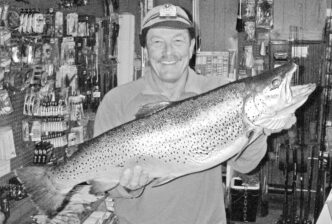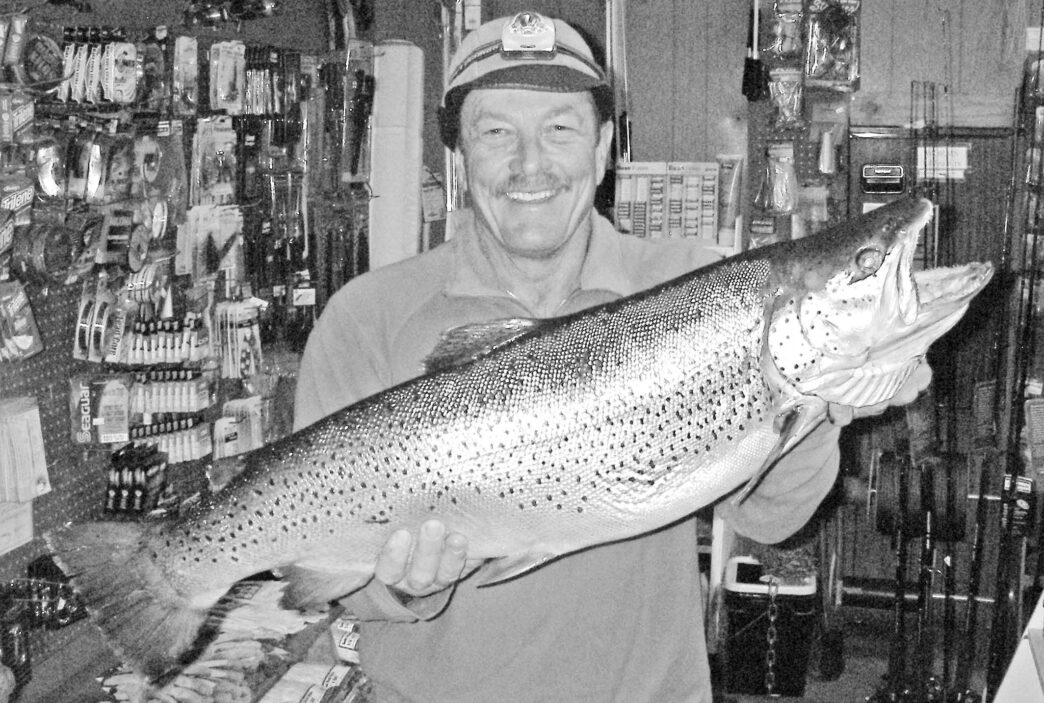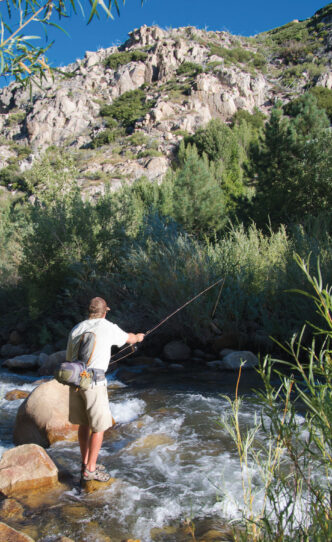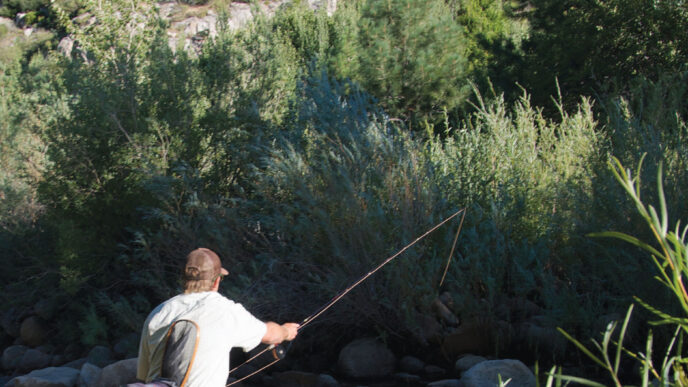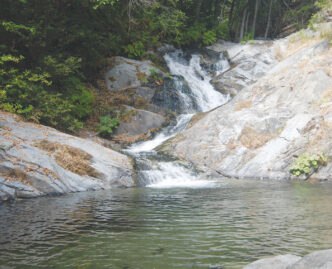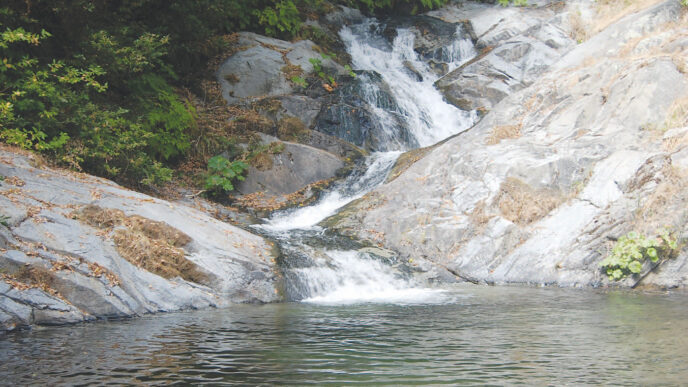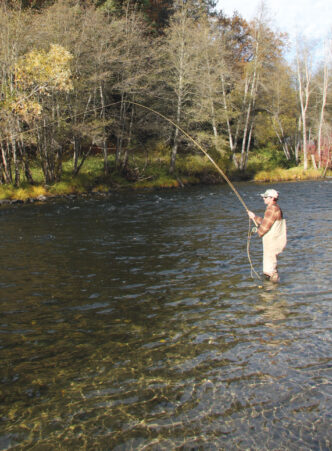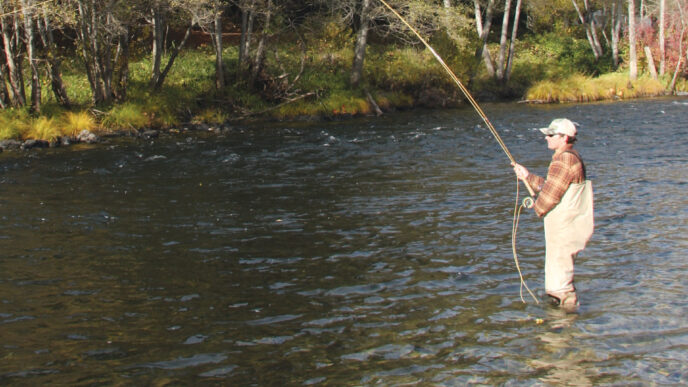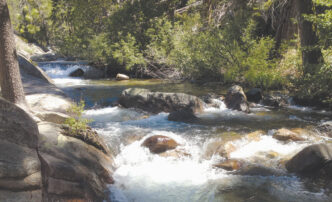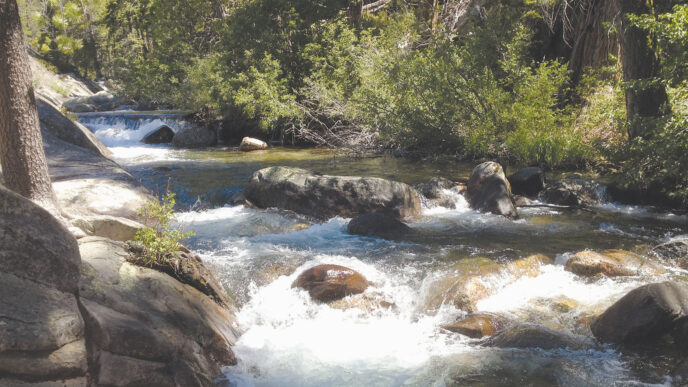At first glance, they aren’t all that impressive: two lakes of modest size astride Robinson Creek in the eastern Sierra’s Toiyabe National Forest. Both lakes are about the same size, hence the name. The upper lake is 265 surface acres, with a maximum depth of 120 feet. The lower lake is marginally larger at 276 acres and just slightly deeper at 160 feet. These are not remote hike-in lakes. A paved road services both, and they are only 12 miles from downtown Bridgeport. In the vast expanse of the eastern Sierra, there are perhaps two hundred waters of comparable size and easy access. What makes these two lakes different?
Big brown trout. These three simple words set the Twin Lakes apart. To be sure, you can catch a lunker brown in many eastern Sierra waters, but for the biggest tackle-busting, net-shredding browns in the state, knowledgeable anglers head for the Twin Lakes. While both lakes have produced very large browns, we are going to concentrate in this article on Lower Twin.
According to Steve Marti of the Twin Lakes Resort (a man who has caught some trophy browns himself ), Lower Twin started off the year with a bang over the opening week of the season, turning out five browns over 10 pounds, with the largest fish weighing 17 pounds. The lake record at Lower Twin is a whopping 20pound monster brown caught by conventional-tackle guru Allan Cole a few years back. (The California state record was caught at the Twin Lakes in 1987 by Brownbagger Danny Steerman of Bakersfield. The giant fish weighed 26 pounds, 8 ounces.)
The Brownbaggers are a group of trophy-trout specialists who fish for the largest brown trout, primarily using big lures shaped and colored to resemble hatchery rainbow trout. At Lower Twin, they might also match the size and color of kokanee salmon or tui chubs, because both of these are eaten by big browns there. Crayfish also are plentiful in Lower Twin, and imitations of these also should be considered, as we will see a bit later.
Conventional-tackle anglers hunting big browns at Lower Twin use a number of methods, but the majority of the true trophy-trout specialists troll lures such as Rapalas or Rebel Minnows on or under the surface on straight monofilament and/or lead-core lines. These lures work best in bad weather, early and late in the day, and early and late in the fishing year — all times when big browns can be found in shallow water. The smartest thing that a fly angler can do when searching the waters of Lower Twin Lake is to adopt this approach as closely as possible. Trolling a large streamer fly from a float tube or small boat is almost identical to the method used by the lure guys.
Success in the Shallows
Although big brown trout normally spend most of their time in deep water, you’ll find them in the shallows very early in the spring, often while there’s still ice around the lake edge, when they come there to feed on any smaller fish they can find, and in the late fall, while they’re searching out spawning habitat. They also come into the shallows in the summer after the sun goes down, but night fishing is not permitted on Mono County waters. Fishing at Twin Lakes is allowed only between sunrise and sunset.
The lousier the weather, the longer that big browns will cruise the shallows. There are many stories of trophy-trout anglers fishing for hours in near-freezing water and even in blinding snow to catch a monster brown. I’m not suggesting you do the same, merely pointing out that you have to work for a really big fish, and the worst weather offers you the best conditions. Equip yourself for overcast, chilly skies and perhaps a bit of rain or occasional spitting snow, and you have a recipe for a brown trout as long as your leg.
This isn’t fun fishing. You’ll get about as cold as you can get and still function. Ice may freeze your fly line in the guides, and in general, you’ll probably wonder why you came to be floating around on a Sierra lake during such awful weather. This is a time when you need all the warmth you can conserve. Eat a hearty, high-calorie breakfast and dress in your best foul-weather gear — long johns, multiple layers of heat-retaining clothing, and the warmest waders you can find. Neoprene is probably best from that standpoint. Wear a winter coat or parka and a warm hat and gloves. If you are float-tubing, you’ll also want to have a floatation device on in case your tube loses air. I like the CO2 inflatable designs.
In low-light and overcast conditions, you can get away with trolling near the surface, using a floating line and a long leader. At normal float-tube paddling speeds, this should keep your fly in the upper 4 or 5 feet of the water column. If conditions are miserable but bright, or during bluebird weather, you’ll want to fish a deep, fast-sinking line to get your streamer down below 10 feet, and you will want to slow the progress of your float tube just a little. I would also recommend that you shorten your leader a few feet to keep the fly down where the line is running. A leader length of 5 or 6 feet out to perhaps 10 feet is about right with a sinking line. With a floating line, lengthen your leader to perhaps 10 to 15 feet or so. Personally, I don’t take the time to fashion tapered leaders for trolling and just use straight mono testing at 8 to 15 pounds.
The Why and How of Boats
Hunting big brown trout in foul weather in a tube is a chancy business at best, and you’d be more comfortable and warmer in a boat. Boats, however, present problems, as well. Many so-called “fishing boats” are underpowered (especially well-worn rental boats), making them difficult to handle in wind and rough water. When you troll for big browns, you can’t run the engine at full throttle, so you don’t have a lot of thrust to help with steering. Three or four miles an hour is about as fast as you should troll a big streamer fly. This may not be fast enough to overcome a strong wind, and the boat will tend to wander.
Trolling with a boat in a straight line just takes paying attention to the direction in which the boat is running, but making a turn is something else again. When you turn at the end of a run, your sinking line slows down and really sinks, and making a turn is generally where you get snagged on the bottom in shallow water. That’s when it’s nice to have a multiplier reel that allows for quick retrieval to keep the fly from snagging. This is also the one place I can think of where you actually might benefit from using an old-fashioned automatic fly reel.
You’ll also discover that most boats can be hard on fly rods. A slip that bangs your rod against the transom or side rail of your boat can seriously damage your rod or even snap it in half. Years ago, after smashing the tip section of a graphite rod on the engine cover of a rental boat, I came up with a good combination that I think you might consider. I don’t often plug a product, but a good choice for trolling is one of Shakespeare’s fly rod Ugly Sticks. They are as nearly bulletproof as anything I’ve used, and buying one is cheap. I like to equip this rod with an old Martin Model 72 multiplier reel that I picked up at a yard sale for a few bucks. So much for having to purchase expensive gear to fish for trophies.
When equipping a boat or float tube for trolling for big brown trout, forget the rod holder. You won’t need it. Hold the rod in your hands and pump it sharply every two or three seconds so the fly darts ahead, then pauses. This darting action is what triggers a strike. You’ll be exhausted after a few hours of this, but it does catch trophy trout.
Fly selection is pretty simple. Tie or buy big streamer flies. Saltwater stuff is what you are looking for, or perhaps patterns used for pike. Try to find flies more than six inches long. You needn’t worry too much about color — big browns will eat an astonishing list of baitfish and small mammals. Simply try to get flies that are dark on the top and light on the bottom. A Double Bunny streamer works well. Remember, you don’t have to cast ’em, just throw ’em in the water and troll.
Stepping Out and Up
You can also catch big browns from the shore at Lower Twin. Parts of the shore have shallow areas with a slope of moderate pitch, so you can wade out quite a ways and cast to deeper water. Even better is adopting the tactic used for catching big Lahontan cutthroat trout at Pyramid Lake in Nevada.
Anglers there often use a tall aluminum stepladder as a casting platform. It allows them to get up out of the cold water and gives them height from which to cast into deeper water. You don’t see the method used much except at Pyramid Lake. One guy who used to do it at Twin Lakes was a contractor named John Bieth. I ran into John while doing research for a lure-fishing article about Twin Lakes some years ago.
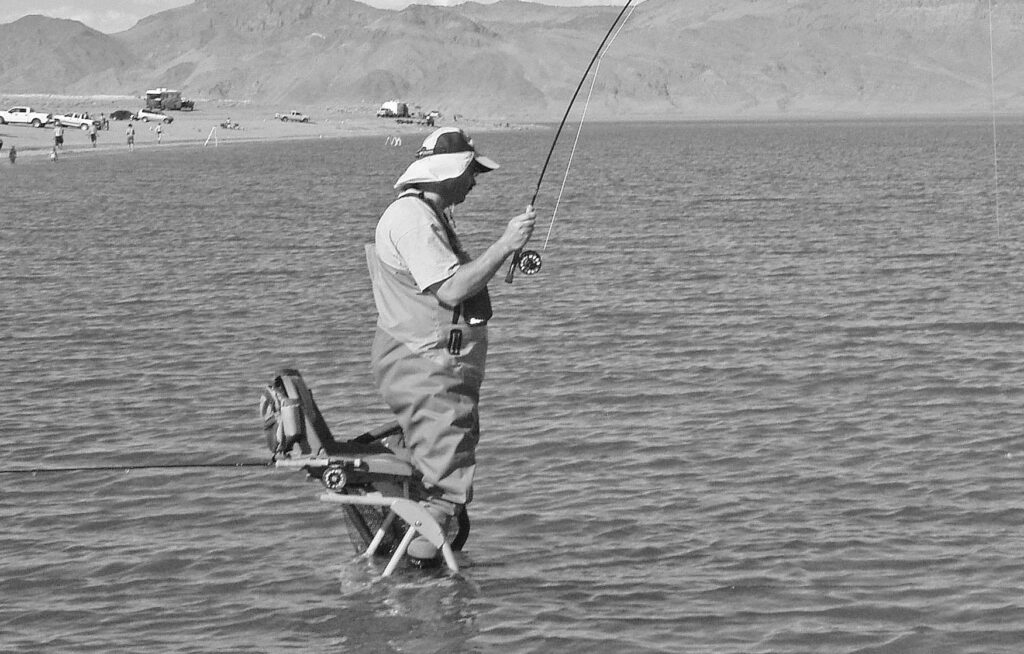
John was fanatic about Twin Lakes browns and had caught them up to 17 pounds, with several over 10 pounds. His method was to perch on an aluminum stepladder set up in water about waist deep, depending on wind and current conditions. (If there are swells coming at you, you need to choose a spot in shallower water when using chest waders.) He would use the ladder both to escape the cold water and to improve his angle of vision into deeper water.
When Bieth detected a big brown cruising along the edge of deeper water, he would cast an Edgewater Wiggler crawfish imitation out ahead of his target and retrieve it slowly, mimicking a crayfish crawling into the shallows. If he couldn’t detect any fish at the edge of the drop-off into deeper water, he would just cast, sometimes all day, figuring he’d connect sooner or later.
Bieth liked to get his gear ready the night before so he could be in the water on his ladder an hour or so before sunup. That way, he stayed in tune with his surroundings and also gave the area time to recover from his wading and placing of the ladder.
Bieth often used spinning tackle to cast the weighted Wiggler fly, but both the fly and the technique easily translate into what you can do with your fly rod. I’d suggest a 9-foot 7-weight rod as a minimum. An 8-weight or 9-weight is better.
This kind of fishing isn’t for every fly angler. You often are miserable, cold, and even soaking wet. It takes fishing all sorts of hours to catch a trophy brown trout. On the other hand, being able to say you caught a trout as long as your leg is pretty nice.
If You Go…
When referring to Twin Lakes, almost all anglers add the word “Bridgeport” to denote that they are talking about the trophy lakes. There are at least two other Twin Lakes, one pair to the south, near Mammoth Lakes, and a single water oddly named Twin Lake in Alpine County. To reach Twin Lakes, Bridgeport, anglers from the San Francisco–Sacramento area head east on Interstate 80 to Highway 89 and then south on Highway 395. From Los Angeles, it’s up Highway 14 to Highway 395 and then north into the eastern Sierra. It’s a fairly long distance from Los Angeles at 440 miles, but only 180 or so from the Sacramento area.
In addition to the huge brown trout, the Twin Lakes offer planted rainbow trout, brook trout, and a fine kokanee salmon fishery. A valid California fishing license is required, and the fishing season runs from the last Saturday in April to November 15 each year. Up-to-the-minute fishing information is available by calling Ken’s Sporting Goods in Bridgeport at (619) 932-7707 or Twin Lakes Resort at (877) 932-7751.
There are several U.S. Forest Service campgrounds with some six hundred campsites along the road paralleling Robinson Creek and also facilities at Mono Village on Upper Twin Lake and Twin Lakes Resort on Lower Twin. Both lakes have launch ramps and rental boats. In addition, there are restaurants, grocery stores, and bait-and-tackle shops. Even more services are available in Bridgeport.
Richard Alden Bean



